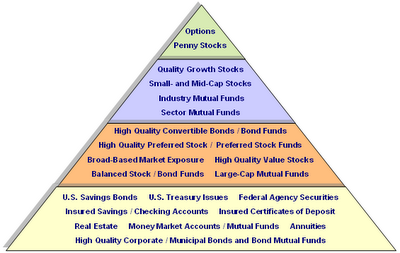Alpha and the Asset Pyramid
 The yellow layer, which includes very low-risk, long-term investments, is still the most important component of a diversified investment portfolio. This layer, more than any other, should be comprised of “buy and hold” investments. This is not an alpha-generating portfolio component, but rather one that provides guaranteed income down the road. As such, our analytics aren’t designed to assist investors within this segment, with the exception of selecting annuities within specific insurance companies.
The yellow layer, which includes very low-risk, long-term investments, is still the most important component of a diversified investment portfolio. This layer, more than any other, should be comprised of “buy and hold” investments. This is not an alpha-generating portfolio component, but rather one that provides guaranteed income down the road. As such, our analytics aren’t designed to assist investors within this segment, with the exception of selecting annuities within specific insurance companies.The orange, blue and green layers, however, are the “portions” of an investment portfolio that I believe can be actively managed in order to generate alpha. Unfortunately, investors often associate active management with “day trading.” In my opinion the two terms are mutually exclusive, as evidence in my Portable Alpha vs. Day Trading post. Day trading, which does provide the potential of generating extraordinary alpha, should be reserved for the very top layer of the asset pyramid, but by no means is a requirement within an investment strategy.
The orange layer, generally speaking, should constitute high-quality, dividend-producing investments as well as vehicles that provide the investor with broad-based market exposure. By nature, investments within this layer tend to be longer-term, but I also believe that investors should maintain a watchful eye and be willing to sell these investments when needed. Currently, there are four broad-based markets which our analytics indicate are generating alpha including the NYSE 100 (NYC) and the S&P 500 (IVV). Additionally, Large Cap Value (JKF) investments are providing alpha for investors looking for a style-box investment. I continue to see weakness in the NASDAQ 100 (QQQQ), the S&P 400 (IJH) and S&P 600 (IJR) as well as the Russell 2000 (IWM).
The blue layer includes investments that are more specialized, representing specific areas of the market that are currently out-performing. Obviously, these investments are shorter-term in nature than the first two layers, but they also have the potential of generating significant alpha. Actively-managing the blue layer is in my opinion the easiest and most efficient way of generating alpha and the modus operandi of our newsletter. Despite last week’s volatile trading sessions, we continue to have eight sectors listed as “buy” recommended including Energy (IYE), Natural Resources (IGE), Utilities (IDU) and Financial Services (IYG). Weakness prevails in five sectors including Biotechnology (IBB) and Transports (IYT).
Lastly, the green layer includes short-term, highly-volatile investments such as options, penny stocks and leveraged investments. This layer represents the smallest percentage of a portfolio’s allocation, and really should only be utilized by investors willing to accept significant risk. Most hedge funds use this portion of an investor’s portfolio to generate alpha, charging exorbitant fees for doing so. Obviously I believe that alpha can be generated without having to pay a hedge fund manager to do it for you.
I hope this helps investors visualize my approach to generating alpha and understand what I mean when I say “actively manage a portion of an overall portfolio.” Buy and Hold remains an important component of investing and is the foundation of any diversified portfolio. But return in excess of the market, a.k.a. alpha, is generated by combining a buy and hold approach with active management, and is easier to practice than most investors think.







0 Comments:
Post a Comment
<< Home